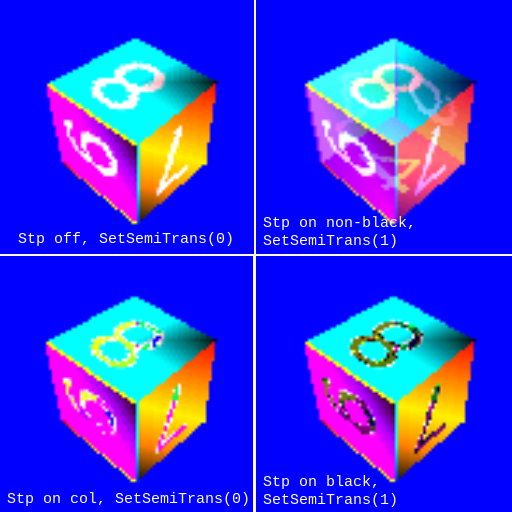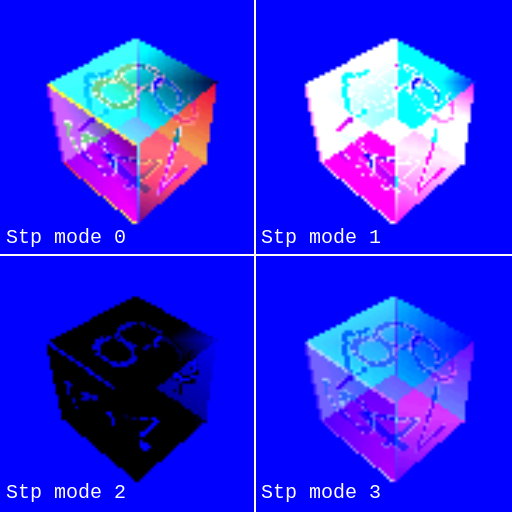6.1 KiB
TIM files
Standard bitmap images that can be transferred directly to the PSX VRAM.
Can be 4bit or 8bit with a CLUT (Colour Look Up Table), 16bit or 24 bit in direct color.
See this page for further information on how information is stored in the 16/24bpp modes.
You can access the TIM mode through TIM_IMAGE->mode. Mode can be :
- 0: 4bits b0
- 1: 8 bits b1
- 2: 16 bits b10
- 3: 24bits b11
- 4: mixed b100
See FileFormat47.pdf, p.179
Transparency
In 16bpp mode, only 15b are used for colors (R 5, G 5, B 5). The 15th bit is defined as the STP or Semi-Transparency flag.
A primitive transparency is set with SetSemiTrans().
The only case where a primitive with unset (=0) STP is transparent is when all values are 0. i.e ; using STP 0, B 0, G 0, R 0
will result in a transparent pixel wether the primitive is set to semi-tranparent or not.
Here are the transparency modes for various values on semi-transparent and opaque primitives :
| STP, B, G, R | (0, 0, 0, 0) | (1, 0, 0, 0) | (0, n, n, n) | (1, n, n, n) |
|---|---|---|---|---|
| Non-transparent primitive | Transparent | Black | Non-transparent | Non-transparent |
| Semi-transparent primitive | Transparent | Semi-transparent | Non-transparent black | Semi-transparent |
See FileFormat47.pdf, p.56, p.192,
LibOver47.pdf, p.107, Table 8-12:
Here is an overview of the various STP modes :
In the following picture, STP refers to the transparency rate mode as seen in LibRef47.pdf, p.306 :
img2tim semi-transparency options
img2tim has several options related to pixel transparency :
-t: Set semi-transparent bit (STP) on non fully black pixels. This will set the STP to 1 on pixels with RGB values different from B0,G0,R0.-usealpha: Use alpha channel (if available) as transparency mask. This will use the converted image's alpha channel (PNG, TGA, TIFF, GIF)-alpt <value>: Threshold value when alpha channel is used as transparency mask (Default: 127). Transparency values above this wil be treated as opaque.-tindex <col>: Specify color index to be treated as transparent (ignored on non palletized images). When using 4bpp/8bpp, specified color to be used as transparent.-tcol <r g b>: Specify RGB color value to be treated as transparent. Same as above for 16bpp.
Tools
You can use open source tools : Gimp, Aseprite
To convert your image files to TIM, use IMG2TIM :
4bpp and 8bpp specificities
If you want to generate 4bpp and 8bpp TIMs, your original image must be in indexed mode with a palette.
-
For 8bpp, < 256 colors , and dimensions must be a multiple of 2
-
For 4bpp, < 16 colors, and dimensions must be a multiple of 4
See FileFormat47.pdf, p.182
You can use TIMTOOL.EXE from legacy PsyQ to check your TIM files, or use Lameguy64's TIMedit
Reproducing the TIM in this example
Image > 4bpp, 8bpp
To convert your images to palettized 4bpp and 8bpp pngs, you can use pngquant :
4bpp (16 colors) image :
pngquant 16 input.png -o output.png --force
8bpp (256 colors) image :
pngquant 256 input.png -o output.png --force
Alternatively, you can use imagemagick :
4bpp (16 colors) image :
convert input.png -colors 16 output.png
8bpp (256 colors) image :
convert input.png -colors 256 output.png
PNG > Tim
img2tim -bpp 4 -org 512 0 -plt 0 481 -usealpha -o TIM4.tim TIM4.png
img2tim -bpp 8 -org 512 256 -plt 0 480 -usealpha -o TIM8.tim TIM8.png
img2tim -bpp 16 -org 768 0 -usealpha -o TIM16.tim TIM16.png
Content of Makefile :
SRCS = hello_sprt.c \
../common/crt0/crt0.s \
TIM/TIM16.tim \
TIM/TIM8.tim \
TIM/TIM4.tim \
Using the TIM file in code
TODO : Make this presentable
// Some structures to handle TIM files
// Access Pixels STP, R, G, B
typedef struct RGB_PIX {
u_int R:5, G:5, B:5, STP:1;
} RGB_PIX;
typedef struct PIXEL {
u_long bnum;
u_short DX, DY;
u_short W, H;
RGB_PIX data[];
} PIXEL;
typedef struct CLUT {
u_long bnum;
u_short DX, DY;
u_short W, H;
u_short clut[];
} CLUT;
typedef struct TIM_FILE_CLUT{
u_long ID;
u_long flag;
u_long clut;
PIXEL pixel[];
} TIM_FILE_CLUT;
typedef struct TIM_FILE{
u_long ID;
u_long flag;
PIXEL pixel[];
} TIM_FILE;
// If we were using C++, we could use templates
//~ struct EmbeddedClut { u_long clut; };
//~ struct NoEmbeddedClut { };
//~ template<has_clut>
//~ struct TIM_FILE {
//~ u_long ID;
//~ u_long flag;
//~ std::conditional<has_clut, EmbeddedClut, NoEmbeddedClut> clut;
//~ PIXEL pixel[];
//~ };
// 16bpp TIM
// STP set on black pixels ( STP, B, R, G == 1, 0, 0 ,0)
extern TIM_FILE _binary_TIM_transBlack_tim_start;
// STP set on image's alpha ( STP, B, R, G == 1, n, n ,n)
extern TIM_FILE _binary_TIM_transAlpha_tim_start;
// STP set on image's alpha ( STP, B, R, G == 1, n, n ,n) with threshold (img2tim -alpt option)
extern TIM_FILE _binary_TIM_transAlphaS_tim_start;
// STP set on 8bpp TIM's CLUT index
extern TIM_FILE _binary_TIM_trans8bpp_tim_start;
// Store in an array so we can iterate over it
TIM_FILE * timFiles[4];
TIM_IMAGE timImages[4];
FntPrint("RGB: %d\n", _binary_TIM_transBlack_tim_start.pixel->data[0].R );
FntPrint("RGB: %d %d %d %d", timFiles[0]->pixel->data[8192].STP, timFiles[0]->pixel->data[8192].R, timFiles[0]->pixel->data[8192].G, timFiles[0]->pixel->data[8192].B );

